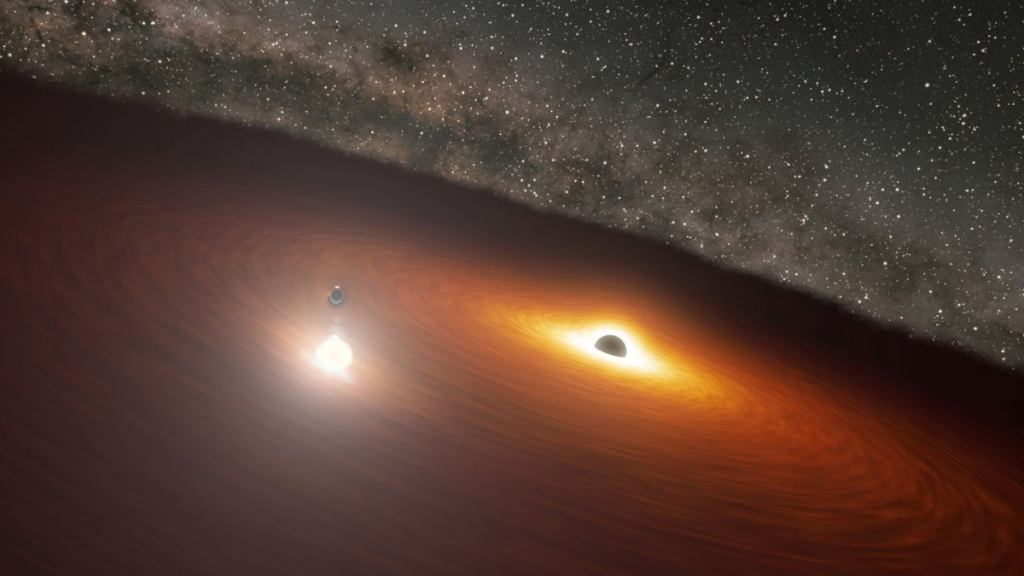Astronomers found a second supermassive black hole in a tumultuous galaxy’s center.
The scientists also found that both cosmic monsters feed on gas and dust and that one has a strange oblong orbit that plunges it into a vast disk of red-hot dust and gas around its partner.
The second black hole in the heart of OJ 287, a galaxy 5 billion light-years distant, weighs 150 million suns. As terrifying as that sounds, the black hole it orbits is considerably more massive—equivalent to almost 18 billion suns—and avidly feeds on surrounding gas and dust in an accretion ring.
Matter from this furious cosmic vortex that doesn’t fall to the supermassive black hole’s surface is funneled to its poles and blasted out as tremendous jets, making the galactic center shine brightly as a quasar.
This accretion disk revealed a second circling supermassive black hole. The second black hole’s descent into the parent black hole’s accretion disk causes flares.
The plunging black hole warms the disk of material, causing it to “burp” hot gas as expanding bubbles, causing flares. Over months, the gas bubbles cool and radiate light and flashes that last two weeks and are brighter than a trillion stars or the Milky Way.

Astronomers can simulate the second black hole’s flattened, oblong orbit and its accretion-disk outbursts using the new study, which precisely forecasts its dives into the disk.
Monster lurks
Over 120 years ago, photographic plates revealed OJ 287, a quasar in Cancer.
This quasar was well-studied, however the black holes appeared as a single dot in measurements. Astronomers only speculated about this AGN’s binary nature after seeing two sorts of radiation.
Aimo Sillanpää, an astronomer at the University of Turku in Finland and co-author of the new research, and his colleagues identified a noticeable pattern in OJ 287 emission four decades ago.
They found two 12-year and 55-year cycles. This showed two black holes whirling around each other, with the shorter cycle indicating the orbital period and the longer cycle being the orbital orientation changing with time.
“The two black holes are so close to each other in the sky that one cannot see them separately; they merge to a single point in our telescopes,” said Mauri Valtonen, the study’s lead astronomer from Finland’s University of Turku. “Only if we clearly separate signals from each black hole can we say that we have actually’seen’ them both.”
Astronomers ultimately saw the secondary black hole falling through the accretion disk and received signals from that second cosmic giant during a 2021/2022 telescope campaign.

“The period in 2021/2022 had a special significance in the study of OJ 287,” Valtonen stated. The secondary black hole was expected to dive into its more massive companion’s accretion disk at this era. The projected blue flash was visible within days after the hit.
Explosive surprises
New observations surprised despite matching forecasts. For instance, the researchers discovered a gigantic flare that was 100 times brighter than a galaxy and lasted only a day.
“According to estimates, the flare occurred shortly after the smaller black hole had received a massive dose of new gas to swallow during its plunge,” Valtonen added. “OJ287 brightens suddenly due to swallowing. This mechanism may have fueled OJ 287’s tiny black hole’s jet. This was anticipated 10 years ago but not proven until today.”
The Fermi Gamma-ray Space Telescope detected the greatest gamma-ray explosion from this system in six years as the secondary black hole plummeted into its bigger partner’s accretion disk. A secondary black hole jet striking gas in the primary accretion disk caused the gamma-ray outburst.
The scientists found a comparable gamma-ray explosion in 2013—the last time the tiny black hole plunged through the accretion disk.
The one-day burst? Why haven’t we seen it?” Valtonen stated. We had horrible luck. Nobody saw OJ287’s one-night stunt.
Astronomers will continue to study the black hole binary at the heart of OJ 287 in the electromagnetic spectrum with an array of telescopes, but the confirmation of a binary black hole pairing makes the system a prime candidate for gravitational wave detection.
Gravitational waves force binary systems to spiral together. OJ 287’s two black holes will unite to become a gigantic black hole.

